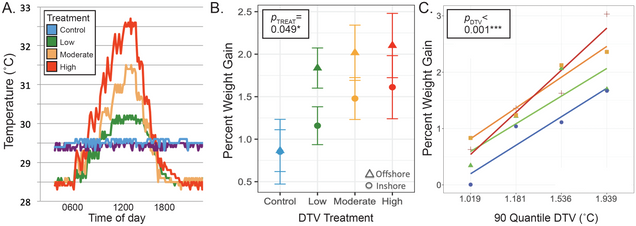Environmental Variability and Coral Resilience
A wide body of work has shown that corals from thermally variable reefs are more tolerant to increases in temperature. One aspect of the Davies lab’s research program is aimed at determining how a coral’s environment modulates its resilience under climate change.
 Our first major project in this realm tests the overarching hypothesis that corals from warmer and more variable environments are adapted to warmer temperatures and exhibit increased plasticity, but that dispersal between reefs incurs a fitness cost. This work was recently funded by the National Science Foundation BIO-OCE program and integrates environmental data, in situ field performance, and genomics to disentangle the independent roles and interactions of adaptation, plasticity, and dispersal in driving coral tolerance to warmer and more variable environments.
Our first major project in this realm tests the overarching hypothesis that corals from warmer and more variable environments are adapted to warmer temperatures and exhibit increased plasticity, but that dispersal between reefs incurs a fitness cost. This work was recently funded by the National Science Foundation BIO-OCE program and integrates environmental data, in situ field performance, and genomics to disentangle the independent roles and interactions of adaptation, plasticity, and dispersal in driving coral tolerance to warmer and more variable environments.
A second project in the lab is investigating how different levels of diel thermal variability (DTV) influence coral (i) fitness, (ii) response to stress, and (iii) recovery from stress. Coral were collected from the Bocas del Toro archipelago in Panama and we ran a relatively long-term (~50day) common garden experiment using our favorite ubiquitous reef-building coral Siderastrea siderea.
This project is being led by PhD candidate Hannah Aichelman. Our work suggests that sourcing corals from thermally variable environments as well as maintaining corals under more thermally variable conditions enhances growth. This work has potentially exciting implications for coral restoration efforts, particularly for building coral nurseries that are more resilient in the face of climate change.
